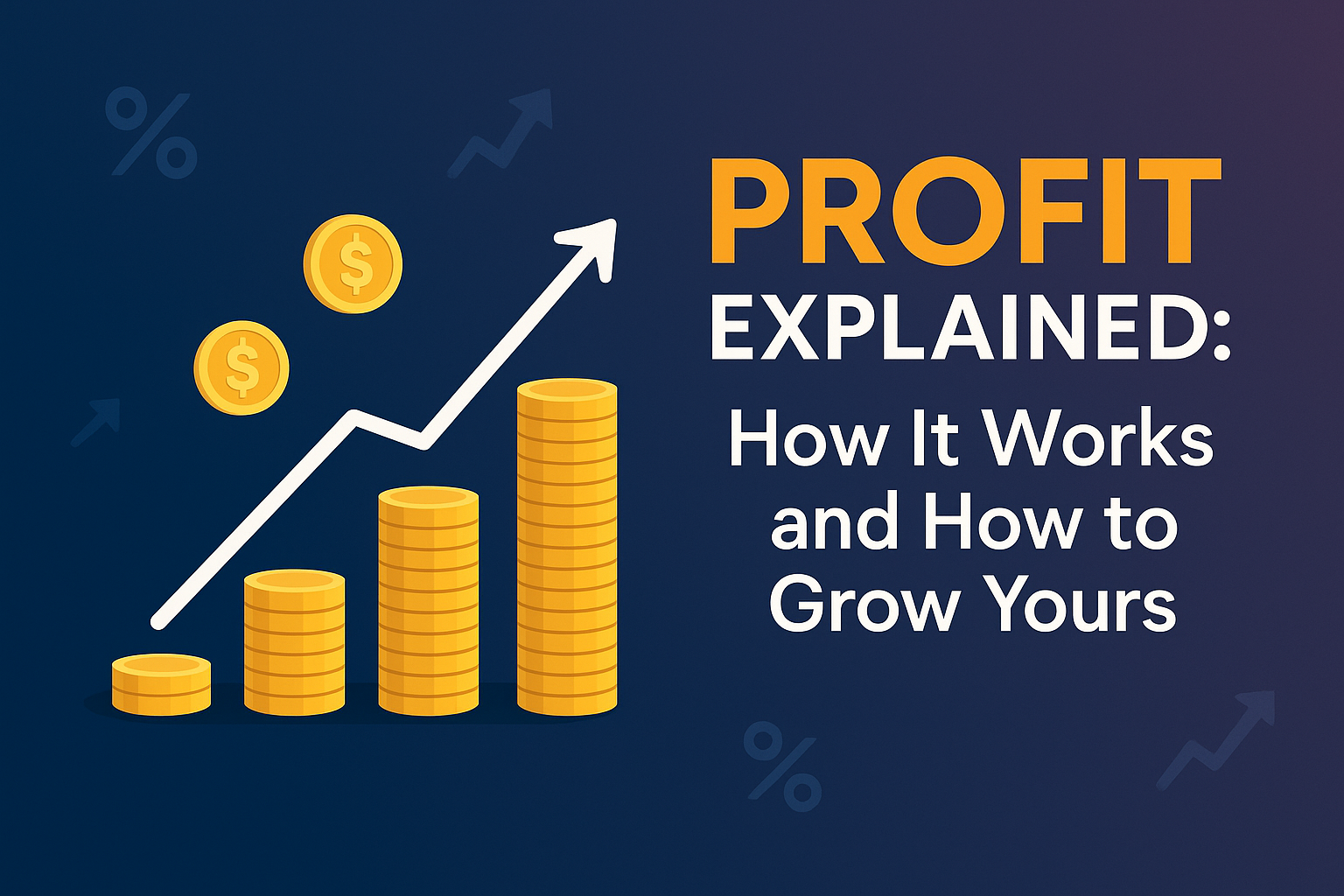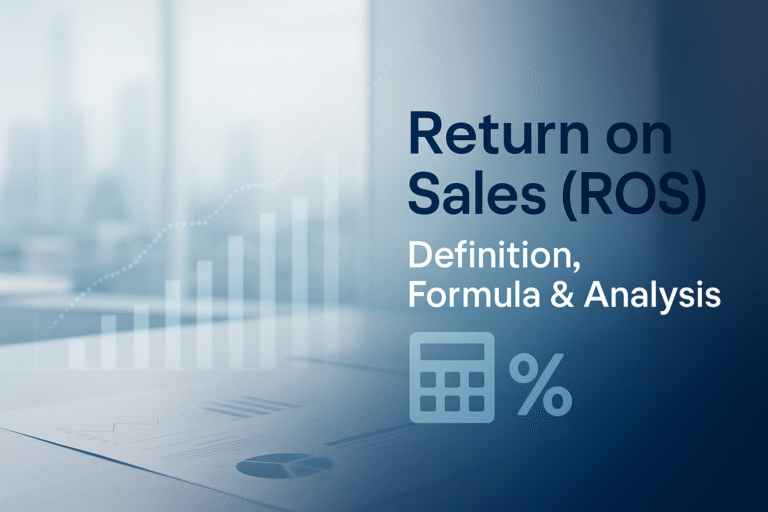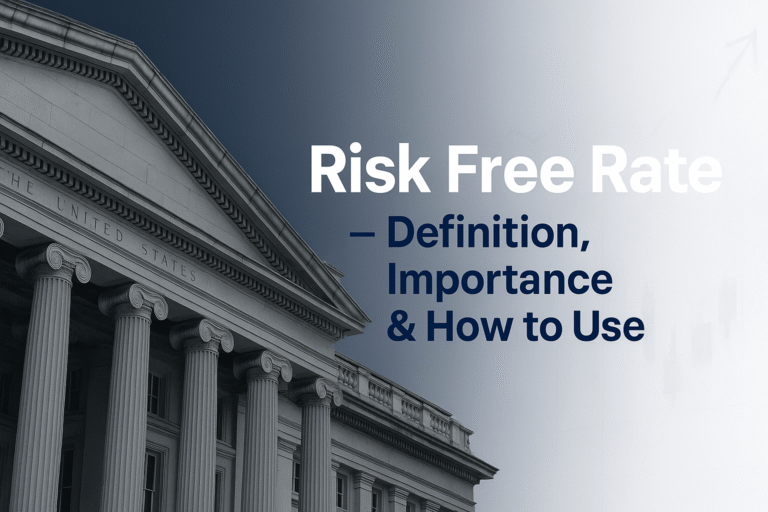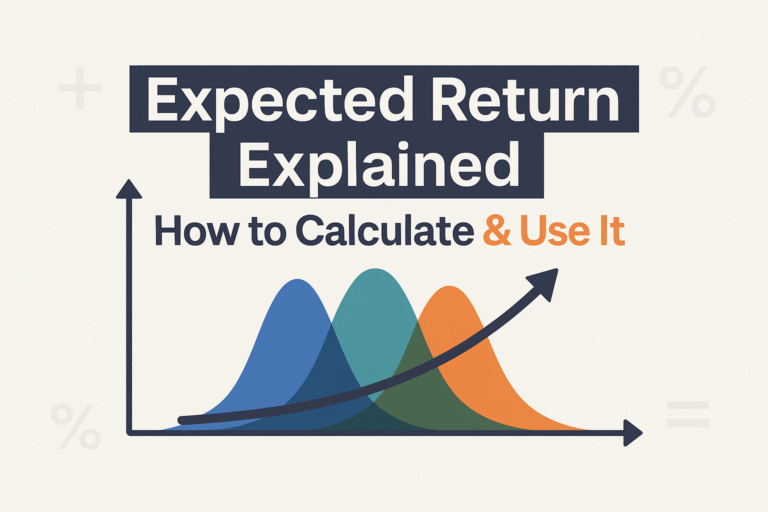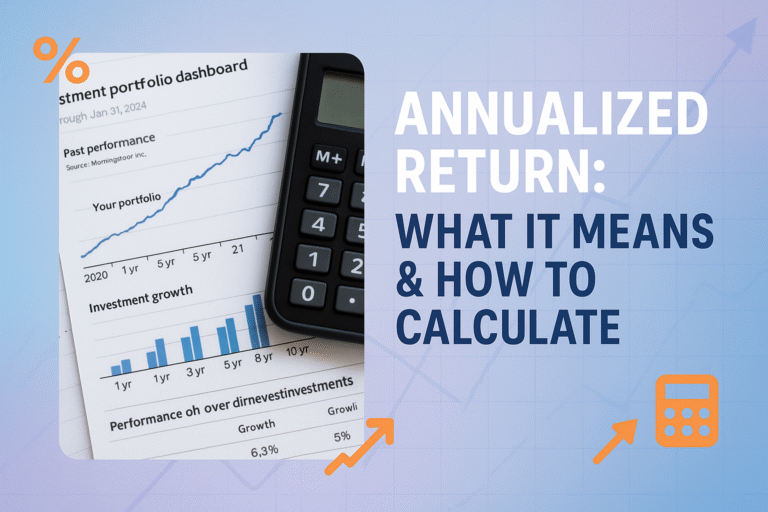Picture this: You’re standing in front of a lemonade stand on a hot summer day. You spent $20 on lemons, sugar, and cups. By the end of the day, you’ve made $50 in sales. That extra $30? That’s profit, and it’s the heartbeat of every business, from your neighborhood lemonade stand to Fortune 500 companies. But here’s the thing: most people think they understand profit until they actually try to grow it.
Whether you’re running a side hustle, managing a small business, or simply trying to make smarter financial decisions, understanding profit isn’t just helpful; it’s essential. In 2025, with economic uncertainty and rising costs, knowing how to calculate, protect, and grow your profit can mean the difference between financial stress and financial freedom.
Key Takeaways
- Profit is what remains after subtracting all expenses from revenue; it’s the true measure of business success
- Three main types of profit (gross, operating, and net) each tell a different story about your financial health
- Growing profit requires a dual approach: increasing revenue while strategically reducing costs
- Profit margins matter more than raw profit numbers when measuring business efficiency
- Sustainable profit growth comes from understanding your numbers, optimizing operations, and making data-driven decisions
What Is Profit, Really?
At its core, profit is the financial gain you make when your revenue exceeds your expenses. It’s the money left over after you’ve paid for everything needed to run your business or investment.
Think of it this way: If you’re selling handmade candles and you bring in $1,000 in sales (revenue) but spend $600 on wax, wicks, jars, marketing, and shipping (expenses), your profit is $400.
The Basic Profit Formula
The fundamental equation is beautifully simple:
Profit = Revenue – Expenses
But here’s where it gets interesting. Not all profit is created equal, and understanding the different types can transform how you manage your money,
The Three Types of Profit You Need to Know
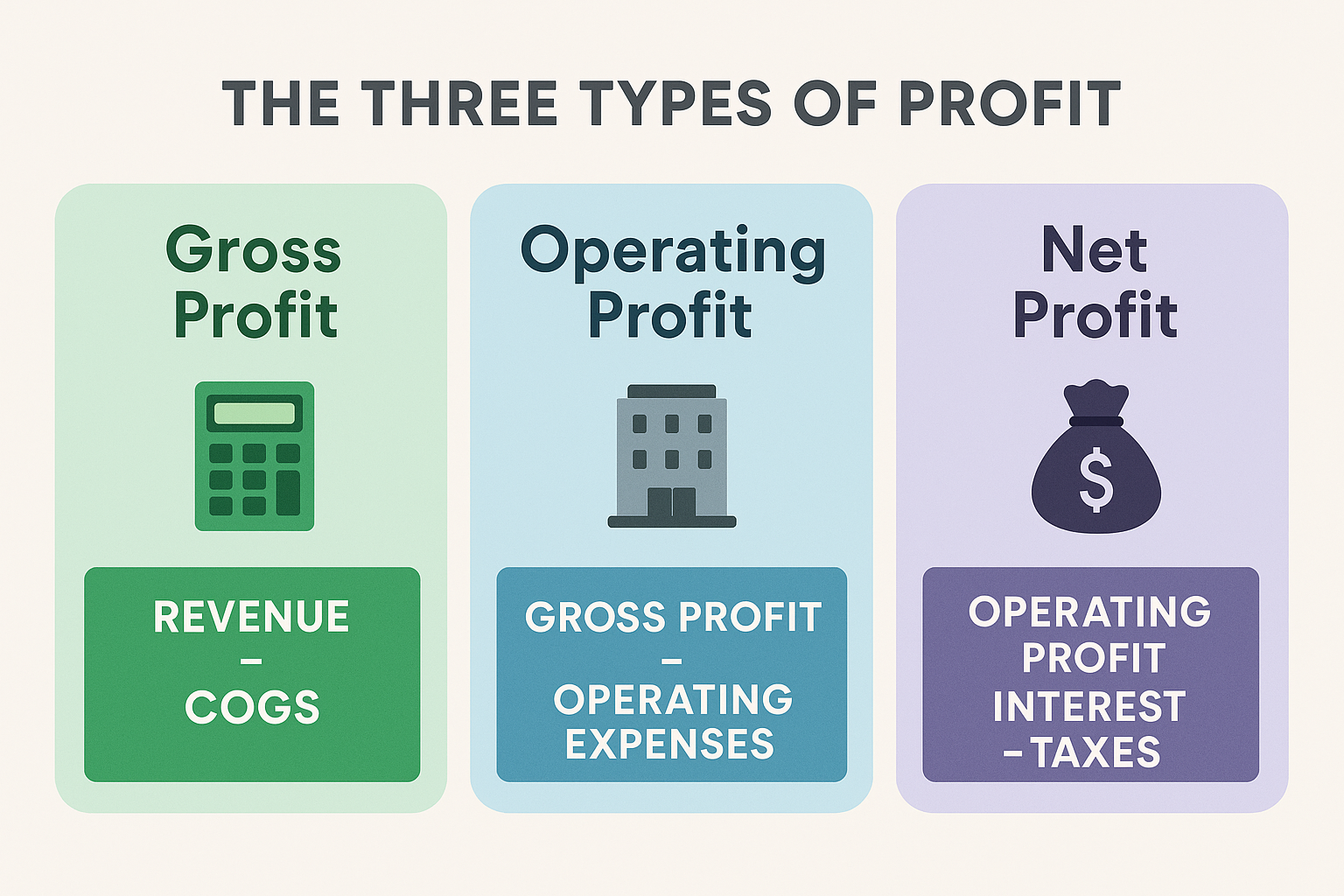
1. Gross Profit
Gross profit is your revenue minus the direct costs of producing your goods or services (called Cost of Goods Sold, or COGS). (Investopedia).”
Formula: Gross Profit = Revenue – COGS
Example: A bakery sells $10,000 worth of bread in a month. The flour, yeast, butter, and other ingredients cost $4,000. Their gross profit is $6,000.
Gross profit tells you how efficiently you’re producing your product, but it doesn’t account for other business expenses like rent, salaries, or marketing.
2. Operating Profit
Operating profit (also called EBIT, Earnings Before Interest and Taxes) goes deeper. It’s your gross profit minus all operating expenses, such as rent, utilities, salaries, and marketing.
Formula: Operating Profit = Gross Profit – Operating Expenses
Example: Using our bakery as an example, if they have $3,500 in monthly operating expenses (rent, employee wages, utilities), their operating profit would be $2,500 ($6,000 – $3,500).
This number reveals whether your core business operations are actually profitable, before accounting for taxes and financing costs.
3. Net Profit
Net profit is the bottom line, literally. It’s what’s left after everything has been paid: production costs, operating expenses, interest on loans, and taxes.
Formula: Net Profit = Operating Profit – (Interest + Taxes)
This is the number that matters most to business owners and investors. It’s the actual money you can reinvest, save, or distribute to owners. When people ask “Are you profitable?” they’re usually talking about net profit.
| Profit Type | What It Includes | What It Tells You |
|---|---|---|
| Gross Profit | Revenue – COGS | Production efficiency |
| Operating Profit | Gross Profit – Operating Expenses | Business operation health |
| Net Profit | Operating Profit – Interest – Taxes | True bottom-line profitability |
Why Profit Margins Matter More Than You Think
Here’s a story: Two friends both run online stores. Sarah makes $100,000 in profit annually. Mark makes $50,000. Who’s doing better?
The answer? You can’t tell without knowing their profit margins.
If Sarah’s revenue is $1,000,000 (10% margin) and Mark’s is $200,000 (25% margin), Mark is actually running a more efficient, sustainable business.
Understanding Profit Margins
Profit margin is your profit expressed as a percentage of revenue:
Profit Margin = (Profit ÷ Revenue) × 100
There are three main margin types:
- Gross Profit Margin = (Gross Profit ÷ Revenue) × 100
- Operating Profit Margin = (Operating Profit ÷ Revenue) × 100
- Net Profit Margin = (Net Profit ÷ Revenue) × 100
Industry benchmarks vary widely:
- Software companies: 15-25% net margins
- Retail businesses: 2-5% net margins
- Restaurants: 3-6% net margins
- Consulting services: 10-20% net margins
Understanding where you stand compared to industry standards helps you set realistic goals and identify improvement opportunities.
The Relationship Between Profit and Revenue
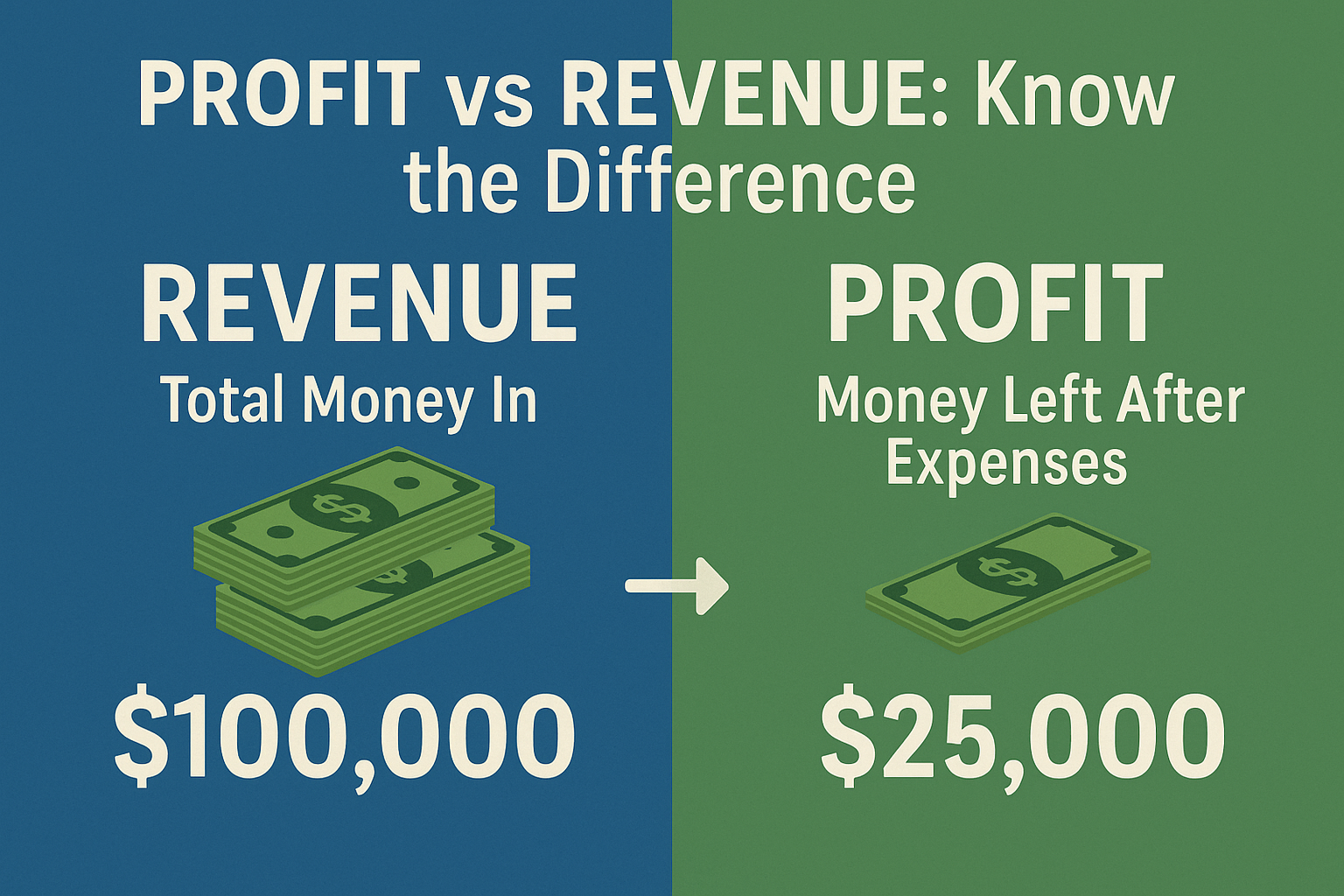
Many beginners confuse revenue with profit, but they’re fundamentally different:
- Revenue (also called sales or turnover) is the total money coming into your business before any expenses
- Profit is what remains after expenses
You can have high revenue and zero profit, or even losses. This happens more often than you’d think, especially with fast-growing startups that prioritize market share over immediate profitability.
Real-World Example: The Revenue Trap
A friend once bragged about his e-commerce store hitting $500,000 in annual revenue. Impressive, right? But when he calculated his actual profit, he was shocked to find he’d only made $15,000, a 3% margin. After paying himself minimum wage for the hours he worked, he was essentially operating at a loss.
This is why understanding why you should invest in your financial education matters; knowing your numbers prevents you from fooling yourself about success.
How to Calculate Your Profit: A Step-by-Step Guide
Let’s walk through a practical example with a fictional freelance graphic designer named Alex.
Step 1: Calculate Total Revenue
- Design projects: $60,000
- Logo packages: $15,000
- Total Revenue: $75,000
Step 2: Identify Direct Costs (COGS)
- Software subscriptions: $1,200
- Stock photos/fonts: $800
- Total COGS: $2,000
Step 3: Calculate Gross Profit
- $75,000 – $2,000 = $73,000 gross profit
Step 4: Subtract Operating Expenses
- Home office rent allocation: $6,000
- Internet/phone: $1,200
- Marketing/advertising: $3,000
- Professional development: $1,500
- Insurance: $800
- Total Operating Expenses: $12,500
Step 5: Calculate Operating Profit
- $73,000 – $12,500 = $60,500 operating profit
Step 6: Account for Interest and Taxes
- Business loan interest: $500
- Estimated taxes (25%): $15,000
- Total: $15,500
Step 7: Calculate Net Profit
- $60,500 – $15,500 = $45,000 net profit
Alex’s net profit margin is 60% ($45,000 ÷ $75,000), which is excellent for a service-based business!
8 Proven Strategies to Grow Your Profit in 2025
Growing profit isn’t about working harder; it’s about working smarter. Here are eight actionable strategies:
1. Increase Your Prices Strategically
Many business owners undercharge out of fear of losing customers. But here’s the truth: a 10% price increase with a 5% customer loss still increases your profit.
Action step: Research competitor pricing, add value to justify increases, and test price changes with new customers first.
2. Reduce Cost of Goods Sold (COGS)
Small reductions in production costs compound dramatically over time.
Tactics:
- Negotiate better rates with suppliers
- Buy materials in bulk for discounts
- Find alternative suppliers without sacrificing quality
- Reduce waste in production processes
3. Optimize Operating Expenses
Review every recurring expense quarterly. Ask: “Is this still necessary? Can we get it cheaper?”
Common savings opportunities:
- Switch to more affordable software alternatives
- Renegotiate insurance policies
- Reduce office space (embrace remote work)
- Automate repetitive tasks
4. Improve Your Product Mix
Not all products or services are equally profitable. Focus energy on your highest-margin offerings.
Example: A coffee shop might discover that specialty drinks have 70% margins while pastries only have 40% margins. Promoting drinks more aggressively increases overall profit.
5. Increase Customer Lifetime Value
Acquiring new customers costs 5-25 times more than retaining existing ones.
Strategies:
- Create loyalty programs
- Offer subscription models
- Upsell and cross-sell complementary products
- Provide exceptional customer service
6. Reduce Customer Acquisition Costs
If you’re spending $100 to acquire a customer who only generates $80 in profit, you’re in trouble.
Tactics:
- Focus on organic marketing (SEO, content marketing)
- Leverage referral programs
- Improve conversion rates on your website
- Use targeted advertising instead of broad campaigns
Similar to how smart moves in investing can compound returns, smart marketing investments compound customer growth.
7. Increase Operational Efficiency
Time is money. Streamlining operations directly impacts your bottom line.
Ideas:
- Automate invoicing and payment collection
- Use project management tools to reduce wasted time
- Standardize processes with checklists and templates
- Train employees to work more efficiently
8. Diversify Revenue Streams
Multiple income sources create stability and growth opportunities.
Just as creating passive income through dividend investing diversifies personal wealth, business revenue diversification protects and grows profit. Consider:
- Adding complementary products or services
- Creating digital products with high margins
- Licensing your intellectual property
- Offering consulting or training
Common Profit Mistakes (And How to Avoid Them)
1: Confusing Cash Flow with Profit
You can be profitable on paper but run out of cash. This happens when:
- Customers pay slowly (accounts receivable)
- You’ve invested heavily in inventory
- You’ve made large upfront purchases
Solution: Track both profit and cash flow separately. Maintain a cash reserve for operational expenses.
2: Ignoring Hidden Costs
Many entrepreneurs forget to account for:
- Their own labor (opportunity cost)
- Equipment depreciation
- Seasonal fluctuations
- Returns and refunds
Solution: Build comprehensive expense tracking systems and review them monthly.
3: Growing Too Fast
Rapid growth often requires significant upfront investment in inventory, staff, and infrastructure, which can temporarily crush profit margins.
Solution: Plan for growth strategically. Ensure you have the capital and systems to support expansion before scaling.
4: Competing Only on Price
Racing to the bottom on pricing is a losing game. There’s always someone willing to charge less.
Solution: Compete on value, quality, service, or specialization instead.
Profit vs Profitability: Understanding the Difference
Profit is an absolute number: “I made $50,000 this year.”
Profitability is relative: “I made a 20% profit margin.”
A business can have high profit but low profitability (large revenue, slim margins). Conversely, a small business might have modest profit but excellent profitability (small revenue, fat margins).
Why it matters: Profitability indicates sustainability and efficiency. Investors and lenders care more about profitability than raw profit numbers because it shows how well you’re managing resources.
How Profit Relates to Business Valuation
When you’re ready to sell your business or attract investors, profit is the primary driver of valuation.
Common valuation methods:
- Multiple of Earnings: Your business might be valued at 3-5x annual net profit (varies by industry)
- Discounted Cash Flow: Future profit projections discounted to present value
- Comparable Sales: What similar businesses sold for based on their profit
A business earning $100,000 annual profit might sell for $300,000-$500,000, depending on growth potential, industry, and other factors.
This is similar to how the stock market values companies; ultimately, it’s about profit generation and growth potential.
Profit in Investing: Making Your Money Work for You
Profit isn’t just for businesses. As an investor, understanding profit helps you evaluate opportunities and build wealth.
Investment Profit Types
Capital Gains: Profit from selling an asset for more than you paid
- Buy stock at $50, sell at $75 = $25 profit per share
Dividend Income: Profit distributed by companies to shareholders
- High dividend stocks can provide steady profit streams
Interest Income: Profit from lending money (bonds, savings accounts)
Calculating Investment Profit
Return on Investment (ROI) = (Current Value – Initial Investment) ÷ Initial Investment × 100
Example: You invest $10,000 in stocks. After a year, it’s worth $12,000.
- ROI = ($12,000 – $10,000) ÷ $10,000 × 100 = 20% return
Understanding why the stock market goes up over time helps you appreciate how profit compounds through long-term investing. (SEC EDGAR).”
Tax Implications of Profit
Profit is taxable income, but smart planning can minimize your tax burden.
Business Profit Taxes
- Sole Proprietors/LLCs: Profit taxed as personal income
- S-Corporations: Profit passes through to owners’ personal returns
- C-Corporations: Profit taxed at the corporate level, then again when distributed as dividends (double taxation)
Reducing Taxable Profit Legally
Legitimate deductions:
- ✅ Business equipment and supplies
- ✅ Home office expenses (if qualified)
- ✅ Professional development and education
- ✅ Retirement contributions (SEP-IRA, Solo 401k)
- ✅ Health insurance premiums (self-employed)
- ✅ Business travel and meals
Action step: Work with a qualified accountant to maximize deductions and minimize taxes while staying compliant.
Profit Reinvestment: The Growth Accelerator
What you do with profit determines your long-term success.
Reinvestment Options
1. Marketing & Customer Acquisition
- Grow your customer base
- Typical allocation: 10-20% of revenue
2. Product Development
- Improve existing offerings
- Create new products/services
3. Team Expansion
- Hire skilled employees
- Invest in training and development
4. Technology & Systems
- Automate processes
- Improve efficiency
5. Emergency Fund
- Build 3-6 months of operating expenses
- Protect against downturns
6. Personal Investments
- Passive income strategies
- Retirement accounts
- Diversified portfolio
The key is balancing reinvestment for growth with taking reasonable profits for personal financial security.
Monitoring Profit: Key Metrics to Track
You can’t improve what you don’t measure. Track these metrics monthly:
Essential Profit Metrics
| Metric | Formula | Target |
|---|---|---|
| Gross Profit Margin | (Gross Profit ÷ Revenue) × 100 | Industry-specific |
| Operating Profit Margin | (Operating Profit ÷ Revenue) × 100 | 10-20% (varies) |
| Net Profit Margin | (Net Profit ÷ Revenue) × 100 | 5-15% (varies) |
| Break-Even Point | Fixed Costs ÷ (Price – Variable Cost per Unit) | Lower is better |
| Return on Assets | Net Profit ÷ Total Assets | >5% |
| Return on Equity | Net Profit ÷ Shareholder Equity | >10-15% |
Tools for Tracking Profit
- Accounting software: QuickBooks, Xero, FreshBooks
- Spreadsheets: Custom profit trackers
- Dashboard tools: Tableau, Google Data Studio
- Bank reconciliation: Weekly reviews
Regular monitoring helps you spot trends, identify problems early, and make data-driven decisions.
Profit During Economic Uncertainty
The economic landscape of 2025 presents unique challenges. Here’s how to protect and grow profit during uncertain times:
Defensive Strategies 🛡️
1. Diversify Revenue Sources
Don’t depend on a single customer or product for most of your income.
2. Build Cash Reserves
Aim for 6-12 months of operating expenses in savings.
3. Focus on Customer Retention
Existing customers are your most valuable asset during downturns.
4. Reduce Fixed Costs
Convert fixed expenses to variable when possible (freelancers vs. full-time staff).
5. Monitor Leading Indicators
Watch industry trends, economic data, and customer behavior for early warning signs.
Understanding market emotion cycles helps you make rational decisions when others panic.
Offensive Strategies 🚀
1. Acquire Distressed Competitors
Downturns create acquisition opportunities.
2. Invest in Marketing
When competitors cut budgets, your marketing becomes more effective.
3. Innovate
Economic pressure forces creative solutions and new opportunities.
4. Strengthen Relationships
Deepen connections with customers, suppliers, and partners.
Real-World Profit Success Stories
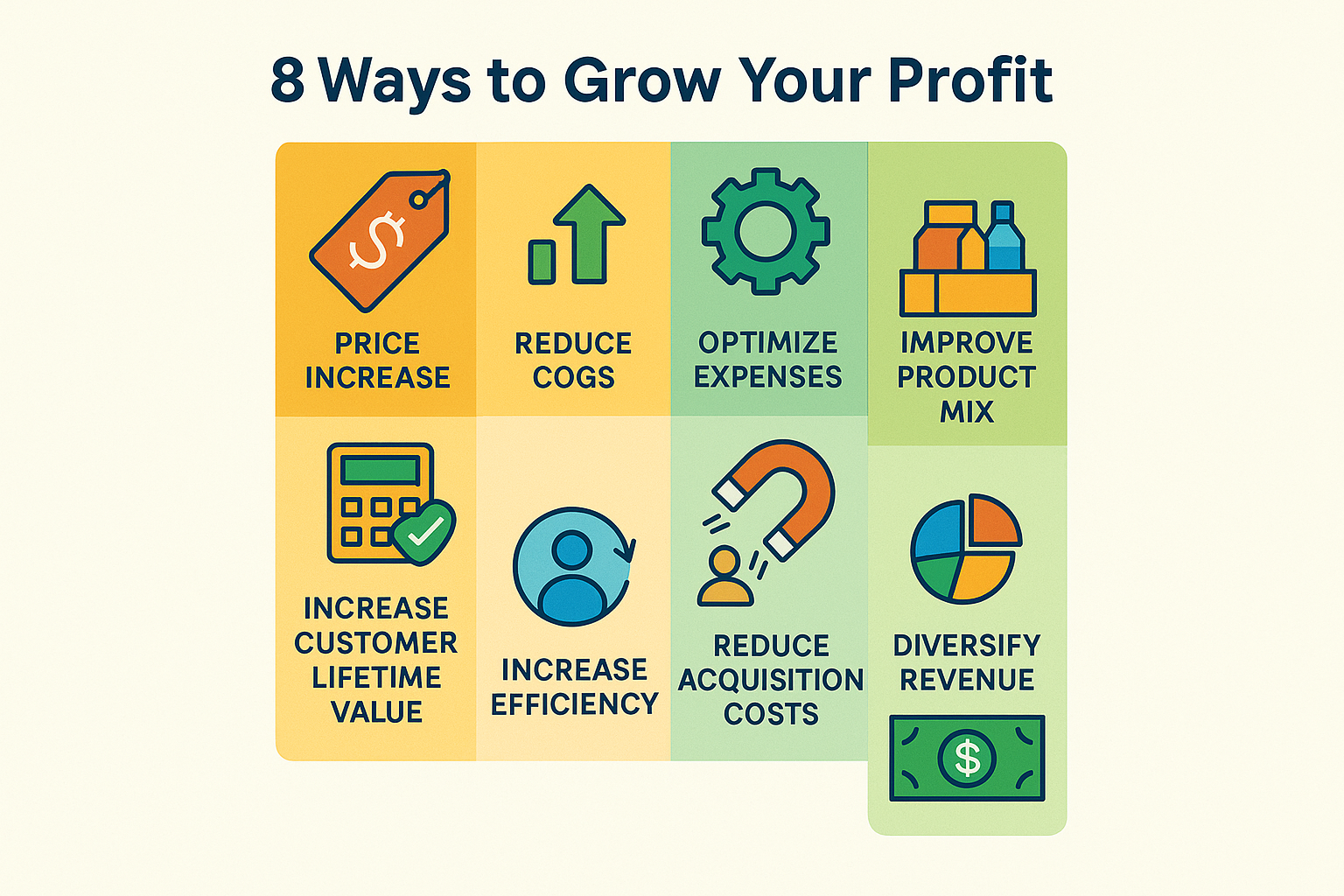
Case Study 1: The Coffee Shop Turnaround
Maria inherited a struggling coffee shop with $300,000 in revenue but only $15,000 in profit (5% margin).
Changes implemented:
- Eliminated low-margin pastries (bought from the supplier)
- Started baking in-house (reduced COGS by 40%)
- Raised prices by 8% (lost only 3% of customers)
- Added a loyalty program (increased repeat visits by 25%)
- Reduced staff overlap during slow hours
Results after 12 months:
- Revenue: $320,000 (slight increase)
- Profit: $64,000 (20% margin)
- 327% profit increase
Case Study 2: The Freelance Pivot
James worked as a freelance writer, charging $50/article. Annual revenue: $40,000. Profit after expenses: $32,000.
Strategic changes:
- Specialized in technical writing for SaaS companies
- Raised rates to $200/article
- Created a content package ($2,000/month retainer)
- Automated client onboarding and invoicing
Results after 18 months:
- Revenue: $95,000
- Profit: $80,000 (84% margin)
- 150% profit increase while working fewer hours
These stories illustrate that profit growth comes from strategic thinking, not just harder work.
Short-term, yes, many startups operate at a loss while building market share. Long-term, no. Eventually, businesses must generate profit to be sustainable.
It varies dramatically by industry. Software: 15-25%. Retail: 2-5%. Restaurants: 3-6%. Compare yourself to industry benchmarks, not other industries.
No. While reinvestment drives growth, you also need personal financial security. A common approach: reinvest 50-70%, take 30-50% as personal income.
Monthly at a minimum. Weekly is better for fast-moving businesses. Annual reviews are too infrequent to catch problems early.
You have a cash flow problem, not a profit problem. Focus on speeding up collections, managing inventory better, and timing expenses.
Q
💰 Profit Calculator & Margin Analyzer
Calculate your gross, operating, and net profit with detailed margin analysis
Gross Profit
Net Profit (Bottom Line)
Gross Margin
Operating Margin
Net Margin
💡 Insight
The Psychology of Profit: Mindset Matters
Understanding profit mechanically is one thing. Developing a profit-oriented mindset is another.
The Abundance vs. Scarcity Mindset
Scarcity thinking: “If I raise prices, I’ll lose all my customers.”
Abundance thinking: “If I raise prices and deliver exceptional value, I’ll attract better customers who appreciate quality.”
Scarcity thinking: “I can’t afford to invest in marketing.”
Abundance thinking: “I can’t afford NOT to invest in marketing; it’s how I grow.”
The most successful business owners view profit not as something to extract, but as a measure of value creation. When you genuinely help customers solve problems, profit naturally follows.
Avoiding the Comparison Trap
It’s easy to look at competitors’ revenue and feel inadequate. But remember: revenue is vanity, profit is sanity.
A business doing $5 million in revenue with 2% margins ($100,000 profit) is less successful than one doing $500,000 in revenue with 40% margins ($200,000 profit), even though the first looks more impressive on paper.
Focus on your own metrics, not others’ highlights.
Building Systems for Sustainable Profit Growth
One-time profit improvements are nice. Systematic, repeatable profit growth is transformative.
The Profit Improvement Framework
1. Measure (Weekly/Monthly)
- Track all key profit metrics
- Compared to previous periods
- Identify trends early
2. Analyze (Monthly)
- Review what’s working and what isn’t
- Identify your most and least profitable products/services
- Find cost reduction opportunities
3. Test (Quarterly)
- Experiment with price changes
- Try new marketing channels
- Test operational improvements
4. Implement (Ongoing)
- Roll out successful tests
- Standardize improvements
- Train team on new processes
5. Scale (Annually)
- Double down on what works
- Eliminate what doesn’t
- Set new profit targets
This cycle creates continuous improvement rather than sporadic efforts.
The Connection Between Profit and Personal Wealth
Business profit and personal wealth are intimately connected but not identical.
Converting Business Profit to Personal Wealth
Owner’s Draw/Salary: Regular income from your business
Retained Earnings: Profit reinvested in the business (increases business value)
Business Sale: Converting total business value to cash
Dividends: Profit distributions (for corporations)
Smart entrepreneurs balance taking profit for personal needs with reinvesting for growth. A common approach:
- Year 1-3: Reinvest 70-80% of profit (growth phase)
- Year 4-7: Reinvest 50-60% of profit (maturity phase)
- Year 8+: Reinvest 30-40% of profit (optimization phase)
Just as dividend investing creates passive income, business profit creates wealth when managed strategically.
Diversifying Beyond Your Business
Don’t keep all your wealth tied up in your business. As profit grows:
- Build a 6-12 month emergency fund
- Max out retirement accounts (SEP-IRA, Solo 401k)
- Invest in diversified assets (learn about smart investing strategies)
- Consider real estate or other businesses
- Protect assets with proper insurance and legal structures
Profit in Different Business Models
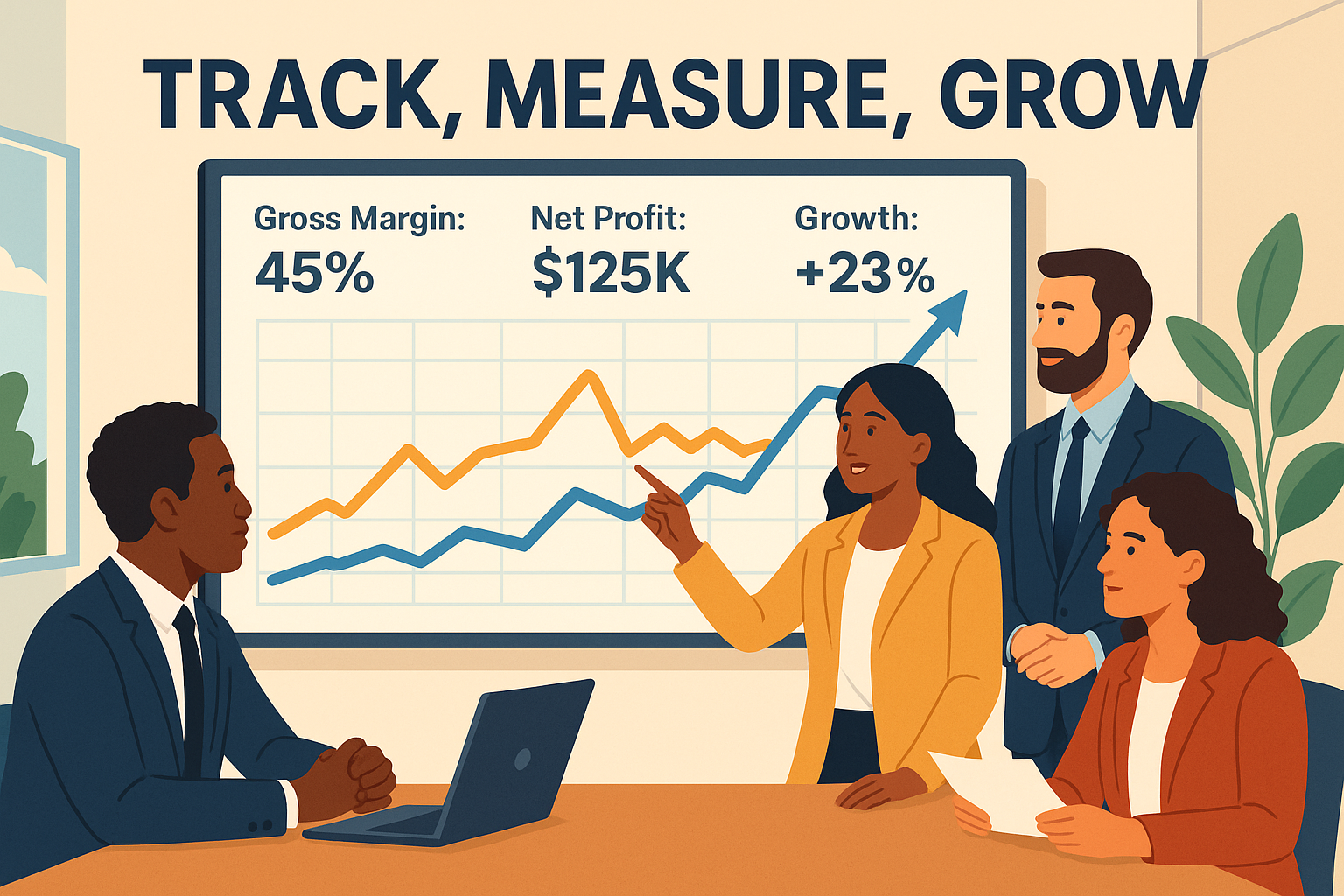
Different business models have vastly different profit characteristics.
Service-Based Businesses
- Typical margins: 15-40%
- Profit drivers: Hourly rates, utilization, efficiency
- Challenges: Limited scalability (time-based)
- Opportunities: High margins, low startup costs
Product-Based Businesses
- Typical margins: 5-30%
- Profit drivers: Unit economics, volume, COGS management
- Challenges: Inventory costs, competition
- Opportunities: Scalability, passive income potential
Subscription/SaaS Businesses
- Typical margins: 20-40%+
- Profit drivers: Customer lifetime value, churn rate, acquisition cost
- Challenges: High upfront development costs
- Opportunities: Predictable revenue, high scalability
Hybrid Models
Combining multiple revenue streams often creates the most resilient profit:
- Consulting + digital products
- E-commerce + subscription boxes
- Services + licensing
Advanced Profit Optimization Techniques
Once you’ve mastered the basics, these advanced strategies can dramatically boost profit:
1. Value-Based Pricing
Instead of cost-plus pricing (cost + margin), charge based on the value you create for customers.
Example: A consultant saves a client $100,000 annually. Charging $30,000 for that service (30% of value created) is easily justified, even if delivery only costs $5,000.
2. The 80/20 Analysis
Identify your top 20% of customers who generate 80% of profit. Focus marketing and service on attracting more like them.
Similarly, identify the bottom 20% of customers who consume resources but generate little profit. Consider raising prices for them or letting them go.
3. Product Mix Optimization
High-volume, low-margin products can build customer relationships.
Low-volume, high-margin products drive profit.
The ideal mix includes both, with careful attention to which products subsidize which.
4. Dynamic Pricing
Adjust prices based on:
- Demand (peak vs. off-peak)
- Customer segment (enterprise vs. small business)
- Purchase timing (early bird vs. last minute)
- Order size (volume discounts)
5. Lifetime Value Maximization
Focus on increasing how much each customer spends over their entire relationship with you:
- Increase purchase frequency: Loyalty programs, subscriptions
- Increase average order value: Bundles, upsells
- Increase retention: Exceptional service, community building
- Decrease acquisition cost: Referrals, organic marketing
Learning from Profit Mistakes: Why Businesses Fail
Understanding common profit mistakes helps you avoid them.
According to U.S. Bureau of Labor Statistics data, about 20% of small businesses fail within the first year, and about 50% within five years. Poor profit management is a leading cause.
Top Profit-Killing Mistakes
1. Underpricing from the start
Many entrepreneurs set prices too low initially, then struggle to raise them later without losing customers.
2. Failing to track metrics
You can’t manage what you don’t measure. Businesses that don’t monitor profit metrics make blind decisions.
3. Growing revenue without scaling profit
Revenue growth that doesn’t improve profit percentage often indicates inefficiency or poor unit economics.
4. Ignoring cash flow
Being “profitable on paper” while running out of cash kills businesses. Similar to why people lose money in the stock market, emotional decisions and poor timing hurt businesses, too.
5. Competing on price alone
The race to the bottom is a race nobody wins. Differentiate on value, not just price.
The Future of Profit in 2025 and Beyond
The business landscape continues evolving. Here’s what’s shaping profit strategies in 2025:
Technology & Automation
AI and automation tools are reducing operating costs dramatically:
- Customer service chatbots
- Automated bookkeeping
- Marketing automation
- Inventory optimization
Impact on profit: Businesses leveraging these tools see 15-30% operating cost reductions.
Sustainability & Ethical Profit
Consumers increasingly favor businesses that balance profit with purpose:
- Sustainable sourcing
- Fair labor practices
- Environmental responsibility
- Community impact
Impact on profit: While potentially increasing costs short term, these practices build brand loyalty and command premium pricing.
Remote & Hybrid Models
Reduced office overhead translates directly to improved margins:
- Lower rent costs
- Reduced utilities
- Smaller equipment needs
- Geographic flexibility for talent
Impact on profit: Companies report 20-40% savings on facilities costs.
Subscription Economy
Recurring revenue models provide predictable profit:
- Software subscriptions
- Membership programs
- Consumable product subscriptions
- Service retainers
Impact on profit: More stable, predictable profit enables better planning and investment.
Your Profit Action Plan: Next Steps
Knowledge without action is worthless. Here’s your practical roadmap:
Week 1: Assessment
- [ ] Calculate your current gross, operating, and net profit
- [ ] Determine your profit margins
- [ ] Compare to industry benchmarks
- [ ] Identify your three biggest expenses
Week 2: Analysis
- [ ] List your top 10 customers by profit (not just revenue)
- [ ] Identify your most and least profitable products/services
- [ ] Review your pricing strategy
- [ ] Analyze competitor pricing
Week 3: Strategy
- [ ] Set specific profit targets for the next quarter
- [ ] Identify 3-5 specific actions to increase profit
- [ ] Prioritize actions by potential impact and ease of implementation
- [ ] Create accountability measures
Week 4: Implementation
- [ ] Execute your top priority action
- [ ] Set up monthly profit tracking systems
- [ ] Schedule quarterly profit reviews
- [ ] Commit to ongoing optimization
Ongoing: Monitor & Adjust
- Weekly: Review key metrics
- Monthly: Analyze trends and adjust tactics
- Quarterly: Major strategic reviews
- Annually: Set new profit goals and celebrate wins
Conclusion: Profit Is Your Business’s Report Card
At the end of the day, profit is the ultimate measure of whether your business is creating real value. It’s not about greed, it’s about sustainability, growth, and having the resources to serve customers better, pay employees fairly, and build the life you want.
Understanding how profit works gives you clarity. Tracking it gives you control. Growing it gives you options.
Whether you’re running a side hustle or managing a growing enterprise, the principles remain the same:
- Know your numbers inside and out
- Focus on value creation, not just cost-cutting
- Price confidently based on the value you deliver
- Continuously optimize operations
- Reinvest strategically for growth
- Balance business profit with personal financial security
The businesses that thrive in 2025 and beyond won’t necessarily be the biggest or flashiest; they’ll be the ones that master the fundamentals of sustainable profit generation.
Start where you are. Use the calculator above to understand your current profit situation. Pick one strategy from this guide and implement it this week. Then build momentum from there.
Remember: every Fortune 500 company started with its first dollar of profit. Your journey to financial success through business profit starts with understanding, measuring, and systematically growing that number.
What will you do this week to improve your profit? The choice, and the opportunity, is yours.
Disclaimer
This article is for educational and informational purposes only and should not be construed as financial, tax, legal, or business advice. Every business situation is unique, and profit strategies should be tailored to your specific circumstances. Consult with qualified accountants, financial advisors, and business consultants before making significant financial decisions. The examples and case studies presented are illustrative and may not reflect typical results. Past performance and examples do not guarantee future outcomes.
About the Author
Max Fonji is a financial educator and founder of TheRichGuyMath.com, where he demystifies complex financial concepts for everyday investors and entrepreneurs. With over a decade of experience in business strategy and personal finance, Max has helped thousands of readers build wealth through smart investing and profitable business practices. His mission is to make financial literacy accessible to everyone, regardless of their starting point. When he’s not analyzing profit margins or market trends, Max enjoys mentoring young entrepreneurs and sharing practical money wisdom that actually works in the real world.

